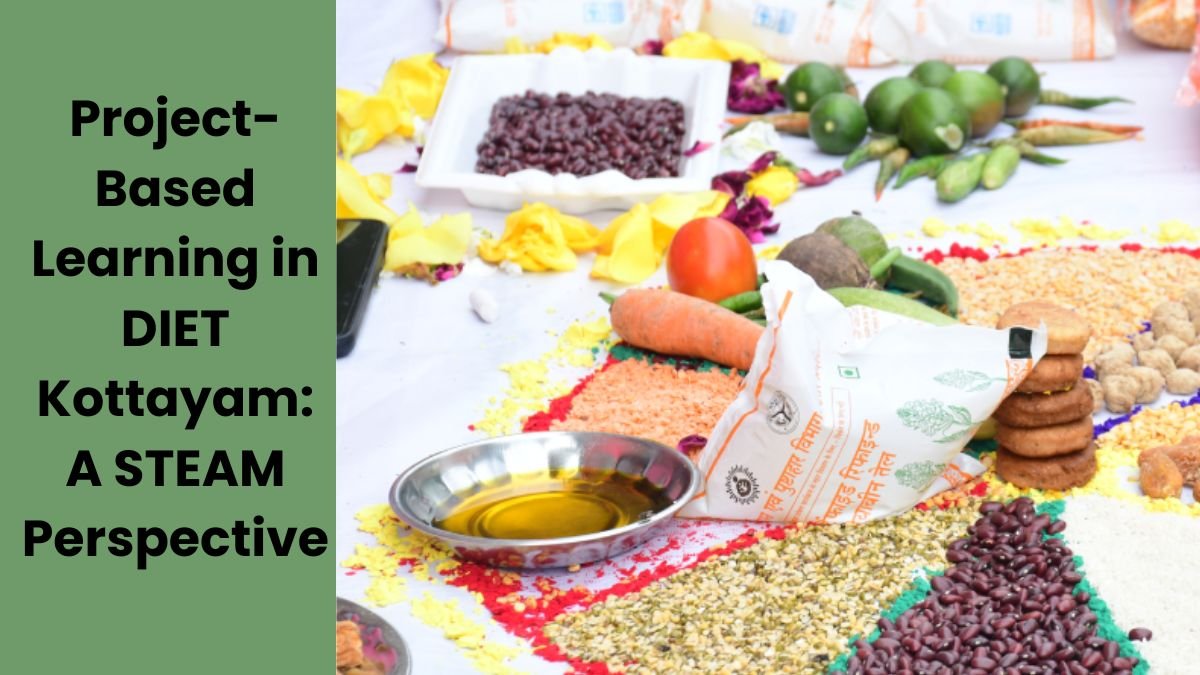Project-Based Learning: A Unique Initiative of STEAM Approach at DIET Kottayam Education is no longer limited to bookish knowledge. Today, students are not just being taught, but are being taught how to learn. With this objective in mind, DIET Kottayam has taken an inspiring initiative in the world of education — Project-Based Learning (PBL), which adopts a comprehensive STEAM (Science, Technology, Engineering, Arts, Mathematics) approach.
This article delves into this innovative initiative to understand how teachers and students at DIET Kottayam are moving beyond traditional education and developing critical skills such as creativity, research and teamwork through project-based learning.
What is Project-Based Learning?
The project-based learning (PBL) is an approach in educational practice, where learners are engaged with a given real-world issue. They are given a project that they carry out in phases namely, planning, research, design, implementation and presentation.
The teacher in this process is to act as the guide and the students to actively learn. Though the command teaching in classrooms offers individual subjects study, PBL focuses on holistic nature in learning through inter-tempering of subjects.
STEAM Approach: Why is it important?
STEAM stands for:
- Science
- Technology
- Engineering
- Arts
- Mathematics
The STEAM approach has not only become the learning model in DIET Kottayam but also a rounded up system. It does not only focus on imparting technical skills to the students but also on building of qualities such as creativity, innovation and teamwork.
The STEAM approach inspires education to think out of the box. For example, instead of simply memorizing a science concept, students learn it practically through a project — for example, building a solar-powered car, or analyzing the quality of a local water source.
Introducing Project-Based Learning at DIET Kottayam
DIET Kottayam created a strategically designed plan to implement PBL in collaboration with STEAM.
It had three main objectives:
- Teacher Capacity Building: The initial stage carried out entailed a kind of knowledge of PBL and STEAM among all the instructors by hosting number of training programs, workshops, and seminars.
- Building a Collaborative Learning Environment: Projects were assigned to students and they were to be in groups. This fostered team building, leadership and problem solving.
- Projects based on local problems: Students were asked to choose problems in their own community for projects — such as plastic waste management, local agricultural challenges, or the school’s water management system.
Major Projects done by DIET Kottayam Students
Below is a list of some of the major projects that DIET Kottayam students successfully executed with their STEAM approach:
Solar Powered Smart Class Model: In this project, students used the principles of science and engineering to create a prototype of a smart class that runs on solar energy. It included lighting, fans and charging ports.
Eco Brick Campaign: Students developed concrete brick-like constructions made of polymer waste that may be applied in construction works. It was a sustainability and recycling project.
Village Water conservation System: Students identified water structures in their village with the help of mathematics and geography and provided the proposal of a model of rainwater harvesting. Their recommendations were acknowledged by the local panchayat.
The advantages of Project-Based Learning
- Enhanced Problem Solving Capability: Students attempt to resolve a problem in real life, which forms Critical Thinking within them.
- Team work and leadership skills: As a team player, students also get to acquire communication, collaboration and leadership skills.
- Heightened Tone and Courage: Project presentation is a skill on how to talk and express on the stage.
- Practical Application of Knowledge: Students experience how science, math and technology are useful in life, not just in books.
Teachers’ Role with STEAM
The role of teachers is crucial to make PBL successful. DIET Kottayam has educated its teachers with the vision to be companions and guides, not just “giver of knowledge”.
They don’t just tell students the answers, but motivate them to ask the right questions. They motivate students to explore, research and experiment.
Challenges and Solutions
Although this initiative of DIET Kottayam has been extremely successful, it did face some challenges:
- Resource limitations: Not all schools had adequate labs or equipment. The local administration and NGOs were consulted to find a solution.
- Time management: PBL is time consuming. Hence, it was difficult to balance it with the curriculum. The solution was to design projects by integrating subjects.
- Parent Perception: Some parents did not understand this new approach. DIET ensured their involvement through Parent Orientation Programmes.
Conclusion:
Revolutionary Step towards Education The Project-Based Learning and STEAM approach adopted by DIET Kottayam has become an exemplary model for India’s educational structure. It is not only making students better citizens and problem solvers, but also preparing them for future jobs and life.
In the future, if every DIET and school in the country takes concrete steps in this direction, we can prepare a new generation of learners – who will not only be employable, but also innovative.
